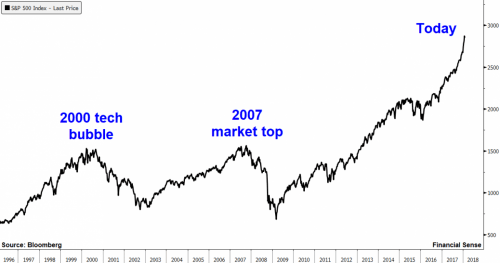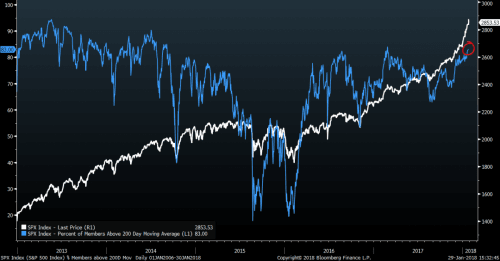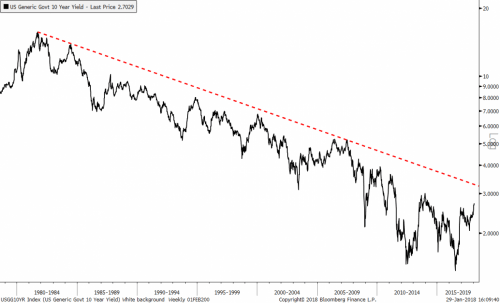Listen to this podcast on our site by clicking here or subscribe on iTunes here.
Since the Trump election, the US stock market has moved nearly straight up with almost no corrections. Putting this into perspective, Jonathan Krinsky, Chief Market Technician for MKM Partners, told Financial Sense Newshour on Saturday that it’s now been 18 months since the last 5% decline, and around 14 months since even a small 3% decline.
[REITs]“Both of those are the longest streaks in history back to 1928,” Krinsky said.
We are seeing some overbought readings in the weekly and monthly RSI that we’ve only seen a handful of times throughout history as well, he noted.
The bigger picture, however, is that every time we’ve seen such extreme overbought readings on a monthly and weekly basis, Krinsky stated, almost none of those instances marked a major market top.
“We know that momentum tends to peak before price,” he said. “Even if we do see a bit of a pause or a pullback here in the coming weeks or months, the odds say that we do go on and at least make a higher high in the market.”
Is there Still Room for Gains?
While we’re seeing stretched valuations and overbought signals akin to what we saw in the 1999 Internet Bubble, the largest difference between what we have now and what we had then is the underlying breadth of this market.
In the late 1990s, we saw narrowing leadership with a handful of stocks doing all the heavy lifting. Currently, 83% of stocks on the S&P are over their 200-day moving average (see chart below) and the cumulative advance-decline lines continue to make new highs. The underlying backdrop of the credit markets remains pretty constructive, as well.
Sources: Financial Sense Wealth Management, Bloomberg
“We’re certainly due for a rest here, but timing any type of peak or top in such a strong uptrend is one of the hardest things to do, and it’s usually unrewarding,” Krinsky said. “The underlying message is, yes things are stretched, but they probably have further to go.”
Interest Rates Not a Threat…Yet
Interest rates recently broke above the key 2.63 to 2.64 level from a short-term basis, Krinsky stated. That opens the door for a move up to 3 percent, which is a psychologically important level and represents a bit of a downtrend from the 2008 highs.
“Interest rates are moving up, and it’s not just in the U.S.,” Krinsky said. “They’re starting to creep up in Germany and even Japan.”
However, before we can say that the secular bull market for bonds is over, he added, we really need to see closing prices above 3.25 to 3.5 on the 10-year to break those long-term downtrends that have been in place for 30 to 40 years (see chart).
Sources: Financial Sense Wealth Management, Bloomberg
“The trend is starting to turn in yields, but it’s probably premature to say we’re going to be extremely up and to the right on interest rates here,” he said. “If we go back to the last time that we saw a secular change in interest rates, from a downtrend in rates to an uptrend in rates, that was the 1930s to the 1940s. That really took really 20 years of building a base before we actually saw a meaningful move above that 4 percent area in 10-year interest rates.”
Concerning Lack of Negative Signals
Not much jumps out as being particularly problematic here.
“If we were to go straight to 3 percent (on 10-year yields) in a couple days, that might spook some parts of the market,” Krinsky said.
The dollar has also been declining for a while year-to-date, and that has boosted parts of the market, and especially emerging markets. A snap-back in the dollar could certainly rattle some parts of the market as well, Krinsky noted, and we certainly are getting some downside extreme levels in the U.S. dollar.
There’s only modest evidence for an increase in inflation here, Krinsky added, but there’s not enough evidence to suggest a threat to markets. Overbought conditions similarly aren’t signaling trouble, necessarily.
“It’s very easy to look at a stock and say it’s very overbought,” Krinsky said. “But if the trend has been in place for quite some time, overbought conditions are often a very big hallmark of bull markets, and they persist much longer than many think is possible.”
Secular Bull Intact
As long as the Fed doesn’t move too quickly to raise rates, this market should have room to run.
If the Fed is moderate or slow, is it possible this goes on for another 18 to 24 months. We broke out of a 12-year secular bear market in 2012 to 2013, so that argues we have more room to run.
“We know that secular bull markets tend to last anywhere from 10 to 18 years,” Krinsky said. “Some global markets are much earlier in their secular breakouts, so another 12 to 24 months in the U.S. would certainly not be out of the question.”
Investors need to be involved in this market, but from a tactical perspective, they should leave a little dry powder for that inevitable dip we will probably get this year.
“Short-term, things are about as overbought as we’ve seen them,” Krinsky said. “We could certainly see a pause or a quick, shallow pullback at any point, but I think when you take a step back and look at the big picture, things still look pretty good to us.”
For more information about Financial Sense® Wealth Management, click here. For a free trial to our FS Insider podcast, click here.
Article by Financial Sense







